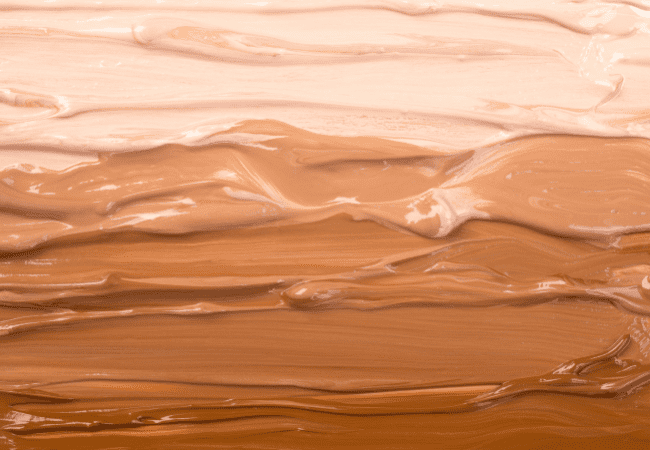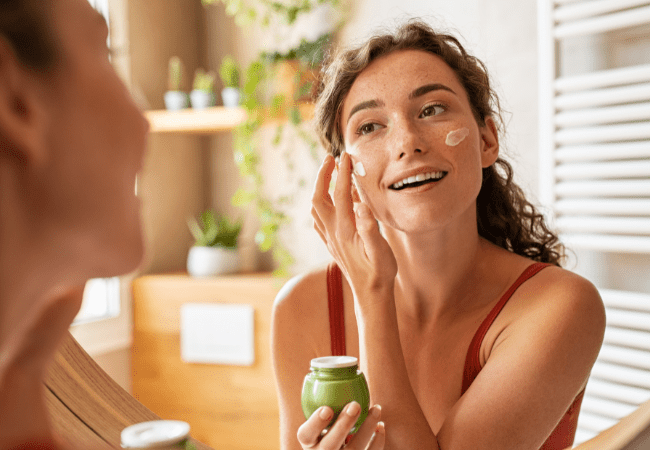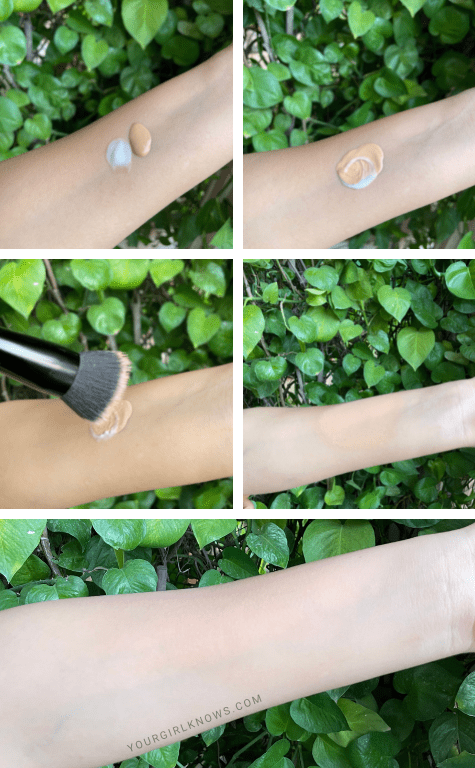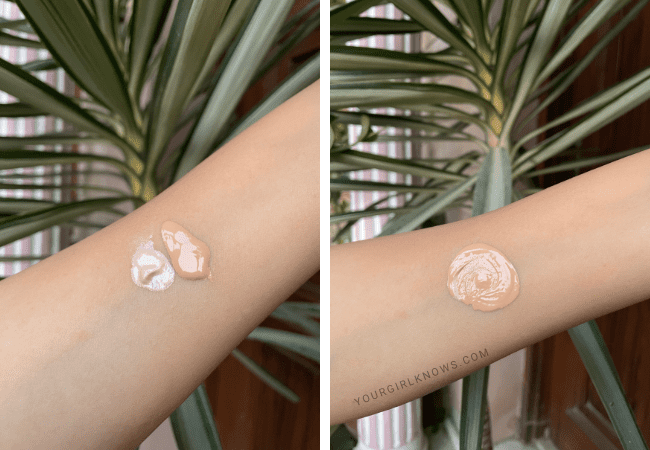I only recommend products I love and I think you will, too. If you click on links I provide, I may receive a little compensation. Learn more.
Looking For Instantly Glowing Skin With Makeup? Try Mixing Foundation With Moisturizer For A Blinding Glow!
There are a few reasons you might want to mix your foundation with a moisturizer.
Sometimes you buy a foundation base, and while it’s perfect for the evening, you want it to be a little bit more dewy and natural for daytime. Or maybe you’ve grabbed a foundation that’s too mattifying or too dark and would like to brighten it up.
Mixing moisturizer and foundation can also be a great way to get more mileage out of a foundation. It can help you achieve the perfect finish for your skin, especially if you are after that no-makeup makeup look.
Whatever your reasons for wanting to mix foundation with moisturizer are, in this blog, we’ve got you covered with our glow-up guide to mixing foundation and moisturizer.
Finding The Perfect Foundation And Moisturizer Duo
Finding The Right Foundation

There’s nothing more frustrating than shelling out your hard-earned cash for a new foundation, only to find out that it’s the wrong shade or it doesn’t work with your skin type.
But never fear! I’m here to help you find the perfect foundation for your needs.
Foundation For Oily Skin
If you have oily skin, you’ll want to stay away from the greasy or heavy foundation. Instead, look for light, oil-free formulas that won’t clog your pores. And if you’re looking for a foundation that will help control oil and shine, a matte foundation might be a perfect choice.
Foundation For Dry Skin
If your skin is on the dry side, you’ll want to steer clear of matte foundations, which can accentuate dryness. Instead, look for foundations with hydrating ingredients like glycerin or hyaluronic acid.
Foundation For Sensitive Skin
There’s nothing more frustrating than having sensitive skin and feeling like you can’t find the right products. It seems like every time you try a new foundation, it ends up making your skin red and irritated. But don’t despair! With a bit of research and perseverance, you can find the perfect foundation for your sensitive skin.
Here are a few things to keep in mind when foundation shopping for sensitive skin:
1. Avoid foundations with harsh chemicals. Look for ones that are labeled
“hypoallergenic” or “for sensitive skin.”
2. Pay attention to the texture of the foundation. If it feels heavy or dry and tacky when you are sampling it, it’s probably not a good choice for sensitive skin.
3. Consider “clean” foundation products that use more natural ingredients.
Once you’ve got that down, you can start thinking about which type of foundation will work best for you. If you’re looking for lighter coverage, you should try a serum foundation or hydrating foundation.
If you want something that can take you from day to evening with a little more oomph, a full-coverage foundation might be more your style. Then you can use our guide to mix it with moisturizer for a lighter daytime look.
Tips For Selecting Your Foundation Shade
When choosing a foundation, it’s important to pick a shade that matches your skin tone. Otherwise, regardless of your makeup application process, you run the risk of your foundation looking cakey and artificial. Also, don’t match the foundation shade with the back of your hand. Instead, match it with your jawline and neck.
There are a few things you can keep in mind when choosing a foundation shade.
- If you have a cool skin tone, you’ll want to look for foundations with a pink or rosy undertone.
- If you have a warm skin tone, you’ll want to look for foundations with a yellow or golden undertone.
- When in doubt, you can always request a sample from your local beauty store to test between a few shades with a warm base, a cool base, or a neutral base that is close to your natural skin tone.
Finding The Right Moisturizer

When it comes to finding the right moisturizer, it can be tough to know where to start. Do you need a water-based or silicone-based option? What about all of the different brands out there?
To help you make the best decision for your skin, let’s take a closer look at water-based and silicone-based moisturizers.
Water Based Moisturizer
Water-based moisturizers are an excellent option for those with normal to oily skin. They’re light and refreshing, and they won’t clog your pores.
Silicone-Based Moisturizers
Silicone-based moisturizers are a great idea for those with dry skin. They’re creamy and luxurious, and they help to lock in moisture.
Tinted Moisturizers
There are plenty of reasons to choose a tinted moisturizer over a normal one. For one, tinted moisturizers often offer SPF protection, which is essential for keeping your skin healthy and free of sun damage.
They also tend to be more lightweight and less greasy than traditional moisturizers, making them ideal for people with oily or combination skin. And, of course, let’s not forget the added bonus of a bit of extra coverage – who doesn’t love a product that can do double duty? A tinted moisturizer might be a good idea for you if you want to have a more natural look all the time and aren’t interested in heavy, full coverage. If you opt for a tinted moisturizer, you won’t need to worry about mixing the moisturizer and foundation.
Should I Select A Moisturizer And Foundation That Has SPF?

There are pros and cons to having SPF already mixed into your foundation or moisturizer. On the one hand, SPF can protect your skin from harmful UV rays and sun damage. On the other hand, some people find that SPF can irritate their skin break and create breakouts or look oily.
If you have oily skin or are prone to breakouts, you may want to skip having SPF in your moisturizer. Instead, a stand-alone sunscreen that’s designed for acne-prone skin could work better for you.
We absolutely love Naked Sunday’s Hydrating Sunscreen Mist for acne-prone and oily skin. It’s a lightweight spray with an SPF 50+ that can be spritzed over makeup to set it. Another holy grail product that has a much better texture and less slippage is the Elta MD SPF 40+.
Serum, Moisturizer Primer, And Illuminator, What Products Are Right For Me?
There’s something about skincare that can make even the most level-headed person become a total product hoarder. Case in point: when it comes to choosing between a serum and a moisturizer, or an illuminator and primer, it can feel like we need to have all of them on hand to achieve that ever-elusive goal of perfect skin. But the truth is, we don’t need all of those products to achieve healthy, happy skin. Here’s a quick guide to help you figure out which products you need, and which products you can skip.
Is Your Number 1 Priority Managing A Skin Problem? Go With A Serum.
Serums are typically lightweight and packed with active ingredients that can penetrate deep into the skin. They’re a great choice for those who are looking to target specific skin concerns, such as fine lines, wrinkles, and dullness. I recommend using a peptide serum if you want to tackle premature aging and lackluster skin. Or if you have oily skin, use a lightweight hyaluronic serum instead of a moisturizer.
Got Dehydrated Skin? Opt For A Moisturizer.
A moisturizer, on the other hand, is thicker than serum and designed to hydrate and nourish the skin. It can be used both morning and night and is an essential step in your skincare routine. Mixing foundation with moisturizer works great for people with younger skin or dehydrated skin wanting to achieve the no makeup look.
A foundation-moisturizer combo can also help you make your own tinted moisturizer!
Tired Of Textural Irregularities Like Large Pores? Try Using A Primer With Your Foundation.
We recommend a primer if you have textural irregularities like large pores or dry patches. This will help to smooth out your skin’s texture and create a more even canvas for your makeup routine. For dry patches, you may want to consider a primer with hydrating properties and a moisturizer to help keep your skin feeling hydrated all day long. Glossier’s two-in-one product the Priming Moisturizer Rich is a life-changer for dry, patchy skin.
Use Illuminator To Boost Radiance.
Whether you’re looking for a dewy glow or a subtle radiance, an illuminator can help you achieve it. Typically illuminator is only used to give you a glowing radiant look when doing your makeup, it won’t have any impact on your skin’s health long term. We recommend adding this to your routine for special occasions or for lackluster skin that needs some extra help to shine.
[ Here are 9 Genius Ways to Apply Highlighter for a Goddess Glow! ]
When it comes to mixing foundation with other products, there are many schools of thought. Adding a serum, illuminator, or moisturizer to your foundation will give you varying results, below we break down the best duos for a few trending looks.
The Best Ways To Mix Foundation Based On Your Ideal Make-Up Look
Mixing Full-Coverage Foundation With Moisturizer For A Sheer Foundation To Achieve The ‘Naked Makeup Look’

If you want a natural, ‘naked makeup’ look, you’ll want to use less foundation product and focus on buildable, sheer coverage. The tip is to start with a small amount of foundation and build it up as needed. Start with a pea size amount, and use 3x the amount of moisturizer versus foundation. If you begin and it seems too sheer, slowly add in another drop of foundation (pea-size amount) and blend until you reach your desired consistency, continually testing on your face as you go. Be cautious, as a small amount of foundation goes a long way. For areas where you want to cover redness, you may want to build up towards a ratio of ⅓ moisturizer ⅔ foundation.
For Glowy, Dewier Lit From Within Skin

For a glowy look, you’ll want to use more highlighting products. Mix your foundation with a few drops of illuminator and a few drops of your favorite face oil. This will help add a healthy-looking glow to your skin. You can then apply the illuminator over your makeup for a bit of extra shine.
To Lighten A Foundation, That’s One Or Two Shades Too Dark
To slightly lighten the pigmentation of the foundation that’s a little bit too dark for your skin color is simple. All you need to do is add one or two drops of a light moisturizer to your dark foundation. You can also use concealer in a lighter shade and apply a lighter powder to lift the overall tone and create your perfect shade.
For Perfectly Smooth Glass Skin Makeup
The glass skin look is a renowned Korean skincare trend that’s known for its ultra-lustrous glossy finish. To nail this look, the focus should be on smooth, hydrated skin. Start your routine by cleansing, exfoliating, and then using a hydrating sheet mask. Then layer on hyaluronic acid.
Next, blending your foundation with a few drops of moisturizer and a few drops of primer will help to ensure it goes on smoothly and doesn’t build up too heavily. To finish the look, use an illuminating serum to highlight your brow, cheeks the bridge of your nose, and your cupid’s bow.
Some Basic Tips Before Mixing Foundation With Moisturizer To Perfect Your Foundation Application
Match The Base Ingredients
Foundations and moisturizers both have different base ingredients that many times don’t mix well with each other. For instance, a water-based foundation should only be mixed with a water-based moisturizer or primer for best results. If you mix it with silicone-based products, you are risking your foundation separating and base makeup looking patchy.
When you prep your skin before adding foundation, you’re also creating a smooth canvas for your foundation to glide on. These simple steps not only help your foundation look its best, but they also will help your skin look its best too.
- Make sure you do a light cleanse and exfoliation to rid your skin of any dirt and dead skin.
- If you have dehydrated skin incorporate sheet masks into your prepping routine. This is also a great tip when doing makeup for a special occasion to add an extra level of hydration and radiance.
- If you are having issues with makeup pilling – use a primer.
- Use a damp makeup sponge. Applying foundation with a damp makeup sponge can help it go on smoothly and reduce the risk of pilling.
Perfect Pairs We Recommend
- For the no-makeup makeup look, try mixing Kiehls Ultra Face Cream and Too Faced Born This Way Foundation; it looks amazing!
- Try this famous hack from Wayne Goss, one of Youtube’s most influential makeup artists. Wayne recommends mixing facial oil like jojoba oil or almond oil with the Dior Forever Skin Glow liquid Foundation for a dewy skin look. I’ve tried this, and it’s a game-changer!
- For the ultimate glass skin, mix Glossier Priming Moisturizer with Chanel Illuminating Fluid and Ilia True Skin Serum Foundation. The result – is flawless, glowing skin.
- Try mixing Estee Lauder Double Wear and a small amount of La Roche Posay Effaclar Oil-Free Moisturizer for oily skin. This combination creates a hydrating natural light coverage without a greasy finish. See what a great Estee lauder foundation dupe is!
Final Thoughts On How To Mix Foundation With Moisturizer
So, what’s the verdict? Ultimately, it comes down to personal preference. Mixing foundation with your favorite moisturizer will always work. But if you want to mix your foundation with another product, go for it! Experiment and see what gives you the best finish. There’s no right or wrong answer here, I recommend trying out a few different approaches to see what suits your skin.

